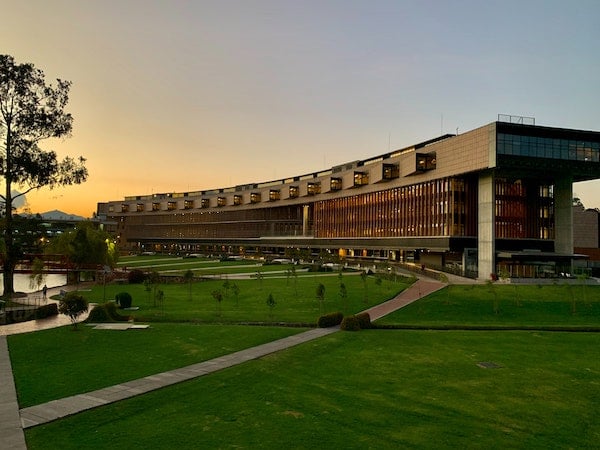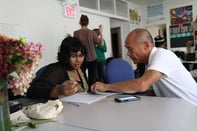Published on
Leveraging Continuing Ed and Workforce Development in Community Colleges

As working adults look to higher ed to help them gain relevant skills, Continuing Education and Workforce Development have the opportunity to thrive. With students at risk of dropping out of community college, it’s important for these institutions to illustrate their value in helping learners get back into the workforce. By developing clear workforce pathways, students see their potential to succeed. In this interview, Angela Long discusses the challenges that continuing ed faces within a community college, the learning opportunities available for adult learners and how Continuing Ed and Workforce Development can serve the needs of both learners and employers.
The EvoLLLution (Evo): What are some of the key obstacles that a continuing ed leader at a community college is going to face when developing programs and support services for non-traditional students?
Angela Long (AL): Without question, community colleges are the workforce engine of America. Representing the Ellis Island of higher education, community colleges service people from a diversity of backgrounds who arrive at our doors with hope in their heart and a dream for a better life. When it comes to workforce and continuing education, the role and the mission of a community college is critical to preparing such individuals for careers in high-demand and high-wage fields with an education that is both timely and affordable.
Given that we now stand at the forefront of the Fourth Industrial Revolution, it is important to understand that jobs and careers are shifting exponentially. It has been reported that 65% of most jobs we train for today will not exist in the coming years. In my work and research, I’ve observed that many students are not given clear direction as to their place and purpose in all of this, let alone imagining their future selves as they seek postsecondary pathways. To date, as many as 50% of all students who attend a community college drop out within their first year of enrollment. Why? Often, students come to college looking for clear direction but ultimately are challenged to find their purpose, sense of belonging and clear direction. For those who can’t find their path and are given the run-around, they often leave and decide that “college just wasn’t for them.” Currently, I sit in a college and district within the poorest zip code in the state of Florida, where approximately 44% of our students are Pell-eligible. A lot of students come from a background of limited financial means. For some, it can take them up to six years to finish a two-year degree, as many work while attending school or have dependents, which as you can imagine can become very challenging. So, we really need to help these students understand their options for a better life through the world of continuing education and clear workforce pathways.
In order to create change in education, we must be willing to ask the tough questions. To give an example, just prior to when the pandemic hit, Tallahassee Community College immediately shifted to this CARE campaign, which stands for Connections, Academics, Resources and Engagement. We had nearly 200 faculty and staff gather in a design-thinking workshop to reflect on the student experience and answer the question, How might TCC redesign its student experience through an innovative model that removes barriers for all students to be successful? Over a two-day period, faculty and staff developed strategies to overcome common barriers our students were facing, which in turn built our CARE initiative.
With the sudden shift to the virtual environment for all classes due to the pandemic, our institution immediately partnered with faculty to host a “When a Pandemic Strikes” workshop via online training. When it came to the workforce, the College looked at the people who lost their jobs and needed to reskill and retrain to get back to work. Under the leadership of TCC’s president Jim Murdaugh, our vice president of workforce innovation, Kimberly Moore, began a campaign with area partners to launch the Be Essential campaign. Individuals within our community were targeted with focused messaging that encouraged them to come to us and in 90 days or less, be certified in a high-demand, high-skilled job in professions such as healthcare. We began working with employers to see what they needed, as well as shifted our teaching and learning paradigm. And our success rates increased with all first-time students by almost 9% college-wide, and this is in the midst of a pandemic. Our Black and Latinx student achievement went up across the board, so clearly some of the things we’re doing have worked.
Evo: How do you create an understanding among your colleagues about the quality of the work and the learning opportunities that take place in a continuing ed shop? And more importantly, how do you separate the idea of the college from the degree?
AL: It matters where you work and who you work with in your community. Florida’s Capitol building is a few miles down the road. Our governor wants to see Florida become number one in the country for workforce and higher education by 2030. Currently, we’re number one in higher education and third or fourth in K-12 education in terms of achievement.
There are 28 colleges in our Florida College System. We understand the importance of continuing education and developing the right workforce pathways. In finding your future self, you need those on- and off-ramps. When people come to us, no matter what their age, they need to know the framework, timeline and requirements they’ll need to get in and out.
Part of the strategic plan is looking at access, student success, workforce, partnerships and how we’re building our resources for these particular programs. In doing this, you need to have a culture where everyone’s on board. Partnerships are key to this process. We have been intentional to partner with national organizations such as the Myers-Briggs company to offer the SuperStrong Inventory to all first-time-in-college students—the Aspen Institute, Achieving the Dream, the National Association of Community College Entrepreneurship and the Association of College and University Educators to name a few. Additionally, we are part of a collective impact group called ASPIRE Capital Region to provide post-secondary opportunities for the most under-served or underrepresented populations in the Leon, Wakulla and Gadsden County area.
That said, we have to rethink how we’re building pathways for career and technical fields to find not just employment, but employment where their skillsets fit. We need to signal to employers that our graduates will meet the needs they’re looking for.
Recently, LinkedIn did a survey of all businesses in the country. They asked what the top two critical skillsets were for this generation. Creativity was number one—the ability to think outside the box—because jobs we’re training for now won’t be there tomorrow. Students will create their own jobs in the future. The second skillset was teamwork.
Our team is doing a great job in building a culture of care. It starts with the faculty, staff, and students. What has been key is that our faculty, staff and students must feel they have ownership in their learning.
Evo: What are the biggest opportunities for the workforce development and continuing ed divisions of community colleges?
AL: Currently, I’m working as an editor on a book about the future of work and learning. In the process, I’ve been talking to innovators and we have discussed the disconnect in education. We’re in this industrialized, very compartmentalized model, but that’s not how the world works. Everything is interdisciplinary. When you step out your door, all of the subjects come at once. They converge. So, we need to be teaching this generation and the next how to think critically.
A lot of people are fearful that artificial intelligence is going to replace all these jobs. But you’re still going to need people to have some role in overseeing the robots that do the jobs. It is critical, no matter what is taught in the classroom, that we build this growth mindset. What are the problems in your community and how do you solve them? We need to do a better job of teaching our students how to think outside the box.
A study conducted in kindergarten found that about 98% of the students were off the charts with creativity. Well, guess what happens? By the time they graduate from high school, it’s almost the opposite. What are we doing in the system to strip people of this risk-taking? Every leader that has ever succeeded has failed, but they had to take a risk to get there. There’s both positive and negative risk-taking, but what we’re not teaching is this freedom to learn from failure. Because every one of us has made mistakes—it’s about how you bounce back from them. It’s part of the scientific method.
A lot of high school students today who are being given the opportunity to graduate with certificates in hand go work for major companies. And they’re questioning the value of college. So, how do we compete and bring value to that process? Not just, “Well, here are wasted credits.” Because really to me, it’s criminal when you take a student who is in poverty, they come to college, take out major loans, take classes, fail a few and now they’re in debt. They usually leave and they have nowhere to go. That’s not okay, but we can fix that. We must change the mindset and we must reorder how we structure our pathways in higher education.
Evo: What are some of the most common myths that folks across the higher ed space tend to have about the work that happens in non-degree, continuing ed divisions?
AL: There’s this mentality that you need to take that traditional route. Again, today, a four-year degree is not enough. Look, I have my doctorate of education and there are people out there who are plumbers, who work in HVAC, and are doing really well, making six figures. Many of these people were willing to take risks. Now, is college important? I think it’s very important, but the critical conversation is what is right for that person. And if somebody says, “Well, I’m going to go into this trade” or “I’m going into this profession,” to me, that is equally valuable as somebody who says, “I’m going to get my doctorate in higher education.” I don’t think that you can weigh one side as more valuable, but we’ve got to overcome those stigmas because the reality is that, with where we’re headed, more and more people are going to be taking the certificate route and creating the at-home gig economy.
Evo: Why are organizations like NCCET so important to the growth of Continuing Education at community colleges?
AL: It’s important that we have connections. You can’t do it on your own. And there are people like you, like me, who really care and want to change the paradigm. Organizations like NCCET are bringing together people who want to innovate. They want to make positive change. They want to close equity gaps. They want to help people find that socio-economic mobility that gets them out of poverty, which is very hard to escape and impacts multiple generations.
Are we creating a system wherein people feel stuck, or are we creating a system wherein we’re teaching the necessary skill sets and mindset to succeed? There are critical skills that a lot of students don’t have, like how to spend money or how to persuade. My colleagues were showing me on LinkedIn how many jobs are primarily sales-focused that make good money, but most people lack the skillset.
Being able to meet other colleagues across the country with the same passion is how we learn from each other. That is so important. Ultimately, the students coming to us need to feel a sense of belonging, need to know their future self, and the potential of where they could be.
We need to start personalizing the experience at a much higher level. That is the way that we are approached in society in business. Education is a business, and we need to approach students in the same way, personalizing that experience as they come to us. They’re not a number; they’re a name.
Evo: Is there anything that you’d like to add about where workforce education and continuing ed is today and where you hope to see it go?
AL: I would love to see more impetus put on the future of work and what that means for continuing education because of the shift we’re seeing today. That’s where the critical conversations have to come in place with the right key industry leaders, business leaders and the innovators of tomorrow.
I’ve met many of them, and I’ll ask what they think the future of higher education means with everything coming. Interestingly, I hear many say there’s going to be a revival of the arts, where humans have a chance to demonstrate their creativity. Yes, artificial intelligence can draw and paint and do different things, but the human mind is unique and irreplaceable. So, there are professions and occupations yet to be developed. But the role of the college, especially community college, is building the pathways to that future and listening intently to what’s going on.
We have to create the solutions. Often, people try to go to all these conferences, and they’re looking for others to provide answers. I’m a firm believer in creating the answer for yourself. That’s what we’re doing. We’re trying to develop the answers—innovating, creating, being willing to take risks. That’s how we’re going to impact the next generation. But at the end of the day, we need to empower our students, so they’re not passive learners.
Students are getting hands-on experiences as opposed to this lecture-driven model, and we need to see more of that. This is a new generation that needs that real-world approach. I would even love to see more paid internships for these students, as they’re trying to explore their options. But building the pathways to the future of work and working with the right partners is going to be so critical in the days to come, and I would really hope future of work institutes are being built.
This interview was edited for length and clarity.
Disclaimer: Embedded links in articles don’t represent author endorsement, but aim to provide readers with additional context and service.
Author Perspective: Administrator
Author Perspective: Community College



